Evaluating the Effects of Early Pruning, Leaf Removal, and Shoot Thinning on ‘MidSouth’ Grapes over Two Consecutive Vintages in South Mississippi
Abstract
:1. Introduction
2. Materials and Methods
3. Results
3.1. Study 1
3.2. Study 2
4. Discussion
5. Conclusions
Author Contributions
Funding
Institutional Review Board Statement
Informed Consent Statement
Data Availability Statement
Acknowledgments
Conflicts of Interest
References
- Stafne, E.T. A history of bunch grape research in Mississippi. J. Amer. Pomol. Soc. 2016, 70, 158–164. [Google Scholar]
- Wine-Searcher. Mississippi Delta–Mississippi Wine. Available online: https://www.winesearcher.com/regions-mississippi+delta+-+mississippi/ (accessed on 10 October 2021).
- Wine-Searcher. Mississippi Wine. Available online: https://www.wine-searcher.com/regions-mississippi (accessed on 10 October 2021).
- Zufferey, V. Leaf respiration in grapevine (Vitis vinifera ‘Chasselas’) in relation to environmental and plant factors. Vitis 2016, 55, 65–72. [Google Scholar] [CrossRef]
- Mortensen, J.A. Grape cultivar choices for wine, juice, jelly, or fresh fruit. In Proceedings of the Second Viniculture Short Course, Mississippi State, MS, USA, 19–20 February 1987. [Google Scholar]
- Stafne, E.T. American Society of Horticultural Science Community Blogs. A Southern Revival? Bunch Grapes in Mississippi. Available online: http://www.ashs.org/blogpost/1288786/223074/A-Southern-Revival-Bunch-Grapes-in-Mississippi/ (accessed on 14 July 2021).
- Williams, H.N.; Stafne, E.T. Reintroducing a multiuse bunch grape for the Deep South: ‘MidSouth’. J. Amer. Pomological Soc. 2022, 76, 20–26. [Google Scholar]
- Haibach, R. Smart Winemaking. Target Sugar and Acid Levels for Popular Wine Grape Varieties. Available online: https://www.smartwinemaking.com/post/optimal-sugar-and-acid-levels-for-popular-wine-grape-varieties (accessed on 14 July 2021).
- Dharmadhikari, M.R.; Wilker, K. Micro Vinification. A Practical Guide to Small-Scale Wine Production; Missouri State Fruit Experiment Station: Mountain Grove, MO, USA, 2001. [Google Scholar]
- Martin, S.R.; Dunn, G.M. Effect of pruning time and hydrogen cyanamide on budburst and subsequent phenology of Vitis vinifera L. variety Cabernet Sauvignon in central Victoria. Aust. J. Grape Wine Res. 2000, 6, 31–39. [Google Scholar] [CrossRef]
- Scarpare, F.V.; Scarpare Filho, J.A.; Rodrigues, A.; Reichardt, K.; Angelocci, L.R. Growing degree-days for the ‘Niagara Rosada’ grapevine pruned in different seasons. Intl. J. Biometeorol. 2012, 56, 823–830. [Google Scholar] [CrossRef]
- VanderWeide, J.; Gottschalk, C.; Schultze, S.R.; Nasrollahiazar, E.; Poni, S.; Sabbatini, P. Impacts of pre-bloom leaf removal on wine grape production and quality parameters: A systematic review and meta-analysis. Frontiers Plant Sci. 2021, 11, 621585. [Google Scholar] [CrossRef]
- Sun, Q.; Sacks, G.L.; Lerch, S.D.; Vanden Heuvel, J.E. Impact of shoot thinning and harvest date on yield components, fruit composition, and wine quality of Marechal Foch. Amer. J. Enol. Vitic. 2011, 62, 32–41. [Google Scholar] [CrossRef] [Green Version]
- Mijowska, K.; Ochmian, I.; Oszmiański, J. Impact of cluster zone leaf removal on grapes cv. regent polyphenol content by the UPLC-PDA/MS method. Molecules 2016, 21, 1688. [Google Scholar] [CrossRef]
- Zenoni, S.; Dal Santo, S.; Tornielli, G.B.; D’Incà, E.; Filippetti, I.; Pastore, C.; Allegro, G.; Silvestroni, O.; Lanari, V.; Pisciotta, A.; et al. Transcriptional responses to pre-flowering leaf defoliation in grapevine berry from different growing sites, years, and genotypes. Frontiers Plant Sci. 2017, 8, 630. [Google Scholar] [CrossRef] [Green Version]
- Creasy, G.L.; Creasy, L.L. Grapes, 2nd ed.; CABI: Boston, MA, USA, 2018. [Google Scholar]
- Jackson, D.I.; Lombard, P.B. Environmental and management practices affecting grape composition and wine quality–a review. Amer. J. Enol. Vitic. 1993, 44, 409–430. [Google Scholar] [CrossRef]
- Feng, H.; Yuan, F.; Skinkis, P.A.; Qian, M.C. Influence of cluster zone leaf removal on Pinot noir grape chemical and volatile composition. Food Chem. 2015, 173, 414–423. [Google Scholar] [CrossRef] [PubMed]
- Hickey, C.C.; Wolf, T.K. Leaf removal effects on Cabernet franc and Petit Verdot: I. Crop yield components and primary fruit composition. Amer. J. Enol. Vitic. 2018, 69, 221–230. [Google Scholar] [CrossRef]
- Hickey, C.C.; Kwasniewski, M.T.; Wolf, T.K. Leaf removal effects on Cabernet franc and Petit Verdot: II. Grape carotenoids, phenolics, and wine sensory analysis. Amer. J. Enol. Vitic. 2018, 69, 231–246. [Google Scholar] [CrossRef]
- Riesterer-Loper, J.; Workmaster, B.A.; Atucha, A. Impact of fruit zone sunlight exposure on ripening profiles of cold climate interspecific hybrid winegrapes. Amer. J. Enol. Vitic. 2019, 70, 286–296. [Google Scholar] [CrossRef]
- Austin, C.N.; Wilcox, W.F. Effects of fruit-zone leaf removal, training systems, and irrigation on the development of grapevine powdery mildew. Amer. J. Enol. Vitic. 2011, 62, 193–198. [Google Scholar] [CrossRef]
- Di Profio, F.; Reynolds, A.G.; Kasimos, A. Canopy management and enzyme impacts on Merlot, Cabernet franc, and Cabernet Sauvignon. II. Wine composition and quality. Amer. J. Enol. Vitic. 2011, 62, 152–168. [Google Scholar] [CrossRef]
- Vogel, A.R.; White, R.S.; MacAllister, C.; Hickey, C.C. Fruit zone leaf removal timing and extent alters bunch rot, primary fruit composition, and crop yield in Georgia-grown ‘Chardonnay’ (Vitis vinifera L.). HortScience 2020, 55, 1654–1661. [Google Scholar] [CrossRef]
- Naor, A.; Gal, Y.; Bravdo, B. Shoot and cluster thinning influence vegetative growth, fruit, yield, and wine quality of ‘Sauvignon blanc’ grapevines. J. Amer. Soc. Hort. Sci. 2002, 127, 628–634. [Google Scholar] [CrossRef] [Green Version]
- Sun, Q.; Sacks, G.L.; Lerch, S.D.; Vanden Heuvel, J.E. Impact of shoot and cluster thinning on yield, fruit composition, and wine quality of Corot noir. Amer. J. Enol. Vitic. 2012, 63, 49–56. [Google Scholar] [CrossRef]
- Chen, J. Spring frost damage to four Pierce’s disease resistant bunch grape cultivars in North Florida. In Proceedings of the Florida State Horticultural Society Annual Meeting, Center for Viticultural Science, Tallahassee, FL, USA, 23–25 July 2000. [Google Scholar]
- Kliewer, W.M.; Dokoozlian, N.K. Leaf area/crop weight ratios of grapevines: Influence on fruit composition and wine quality. Amer. J. Enol. Vitic. 2005, 56, 170–181. [Google Scholar] [CrossRef]
- Hunter, J.J.; Visser, J.H. The effect of partial defoliation, leaf position and developmental stage of the vine on the photosynthetic activity of Vitis vinifera L. cv Cabernet Sauvignon. S. Afr. J. Enol. Vitic. 1988, 9, 9–15. [Google Scholar] [CrossRef] [Green Version]
- Kok, D.; Bal, E.; Celik, S. Influences of various canopy management techniques on wine grape quality of V. vinifera L. cv. Kalecik Karasi. Bulg. J. Agric. Sci. 2013, 19, 1247–1252. [Google Scholar]
- Overcash, J.P.; Hegwood, C.P.; Stojanovic, B.J. ‘MidSouth’ and ‘MissBlue’–two new bunch grape cultivars. Miss. Agric. For. Exp. Stn. Res. Rep. 1981, 6, 7–8. [Google Scholar]
- Stafne, E.T.; Carroll, B.L.; Marshall-Shaw, D. Effect of precocious grapevine fruiting on subsequent year’s growth and yield. J. Amer. Pomological Soc. 2017, 71, 47–54. [Google Scholar]
- Skinkis, P. Grapes. Basic Concept of Vine Balance. Available online: https://grapes.extension.org/basic-concept-of-vine-balance/ (accessed on 21 December 2021).
- Pearce, I.; Coombe, B.G. Revised version of Grapevine growth stages–The modified E-L system. In Viticulture 1: Resources, 2nd ed.; Coombe, B., Dry, P., Eds.; Winetitles Pty Ltd: Broadview, South Australia, 2004; p. 153. [Google Scholar]
- Hoffman, L.E.; Wilcox, W.F. Utilizing epidemiological investigations to optimize management of grape black rot. Phytopathology 2002, 92, 676–680. [Google Scholar] [CrossRef] [PubMed]
- Stafne, E.T. Mississippi State University Extension Fruit and Nut Review: Bunch Grapes. Available online: http://extension.msstate.edu/publications/information-sheets/fruit-and-nut-review-bunch-grapes/ (accessed on 15 November 2021).
- Intrigliolo, D.S.; Castel, J.R. Response of grapevine cv. ‘Tempranillo’ to timing and amount of irrigation: Water relations, vine growth, yield and berry and wine composition. Irrig. Sci. 2010, 28, 113–125. [Google Scholar] [CrossRef]
- Famiani, F.; Farinelli, D.; Palliotti, A.; Moscatello, S.; Battistelli, A.; Walker, R.P. Is stored malate the quantitatively most important substrate utilised by respiration and ethanolic fermentation in grape berry pericarp during ripening? Plant Physiol. Biochem. 2014, 76, 52–57. [Google Scholar] [CrossRef]
- Shahood, R.; Torregrosa, L.; Savoi, S.; Romieu, C. First quantitative assessment of growth, sugar accumulation and malate breakdown in a single ripening berry. Oeno One 2020, 54, 1077–1092. [Google Scholar] [CrossRef]
- Walker, R.P.; Bonghi, C.; Varotto, S.; Battistelli, A.; Burbidge, C.A.; Castellarin, S.D.; Chen, Z.; Darriet, P.; Moscatello, S.; Rienth, M.; et al. Sucrose metabolism and transport in grapevines, with emphasis on berries and leaves, and insights gained from a cross-species comparison. Intl. J. Molecular Sci. 2021, 22, 7794. [Google Scholar] [CrossRef]
- Jain, A.K.; Basha, S.M.; Lorenzo, A.B.; Lu, J.; Leong, S. Variation in the sugar accumulation pattern of muscadine grape genotypes. In Proceedings of the Florida State Horticultural Society Annual Meeting. Center for Viticulture and Small Fruits, Tallahassee, FL, USA, 2–4 June 2002. [Google Scholar]
- Ramos, M.C.; Pérez-Álvarez, E.P.; Peregrina, F.; de Toda, F.M. Relationships between grape composition of Tempranillo variety and available soil water and water stress under different weather conditions. Scientia Hort. 2020, 262, 109063. [Google Scholar] [CrossRef]
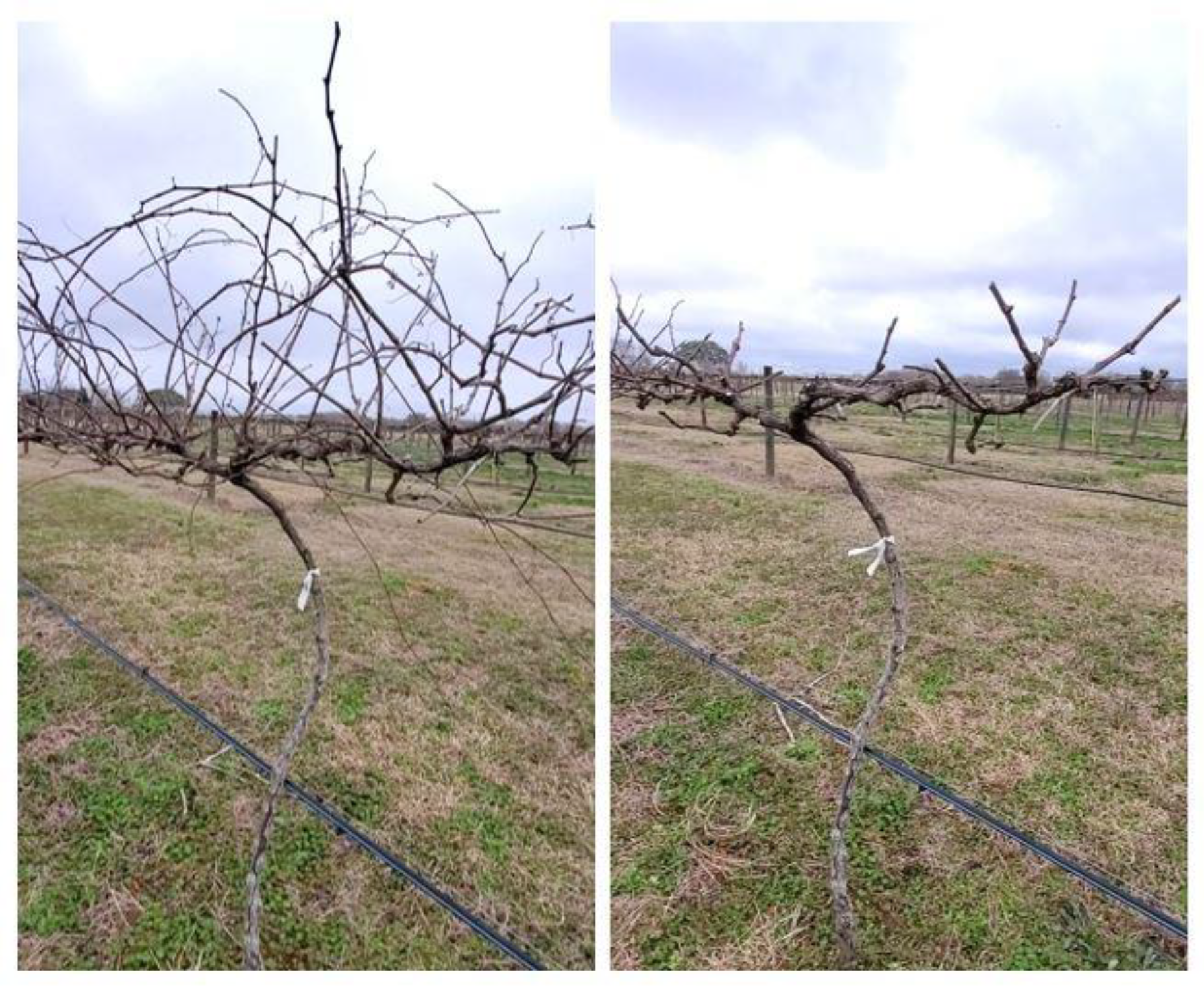
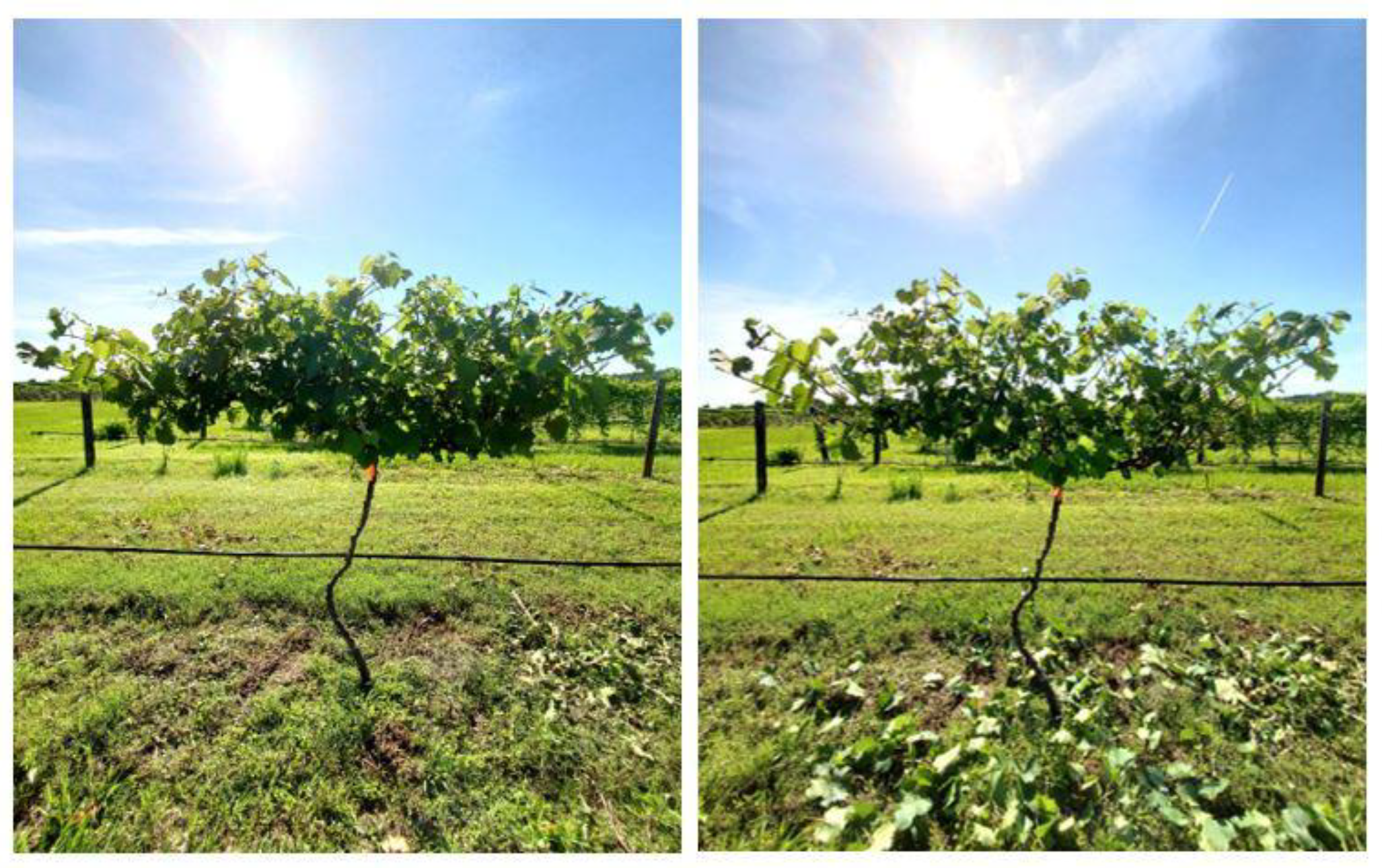
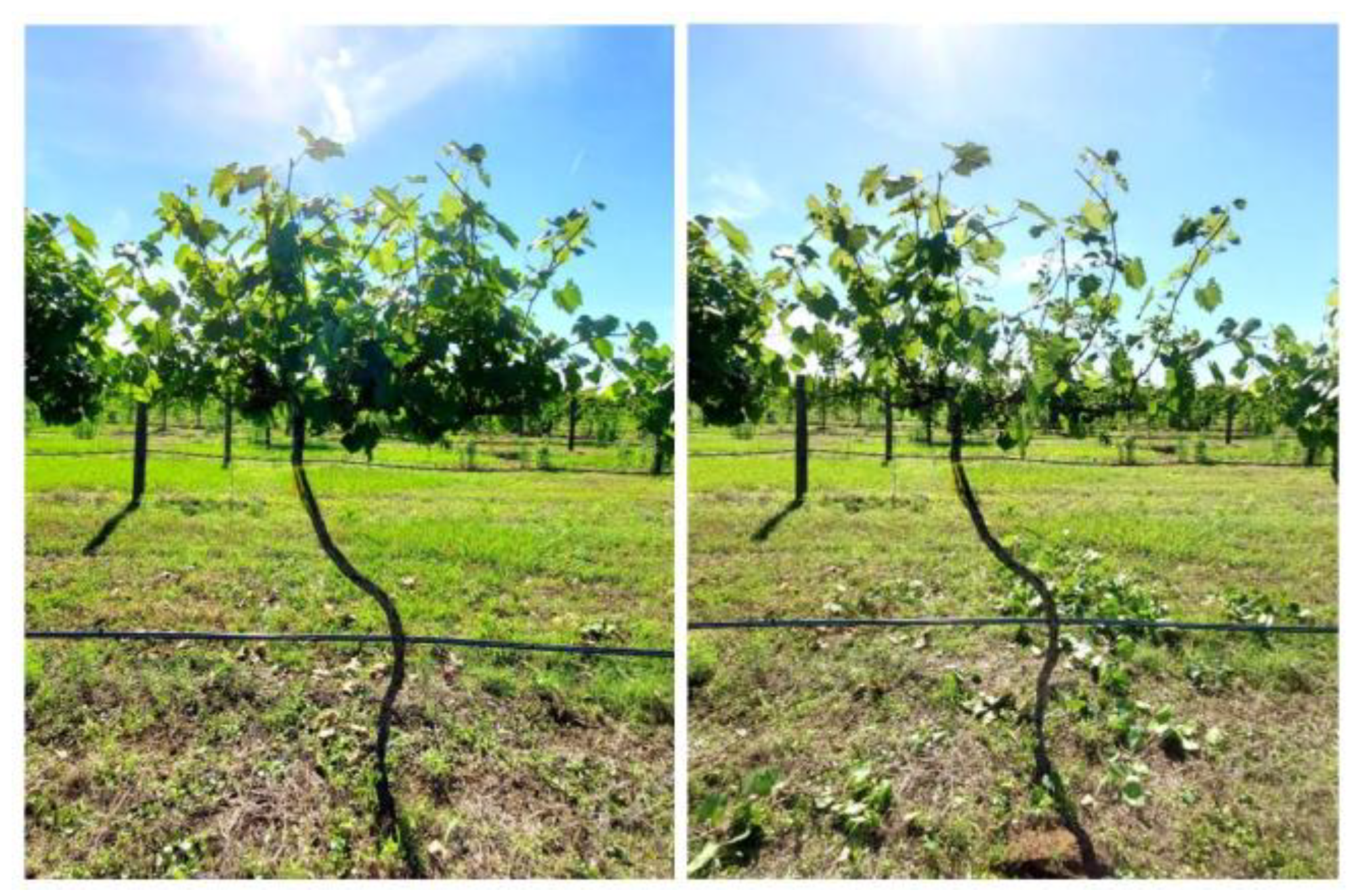
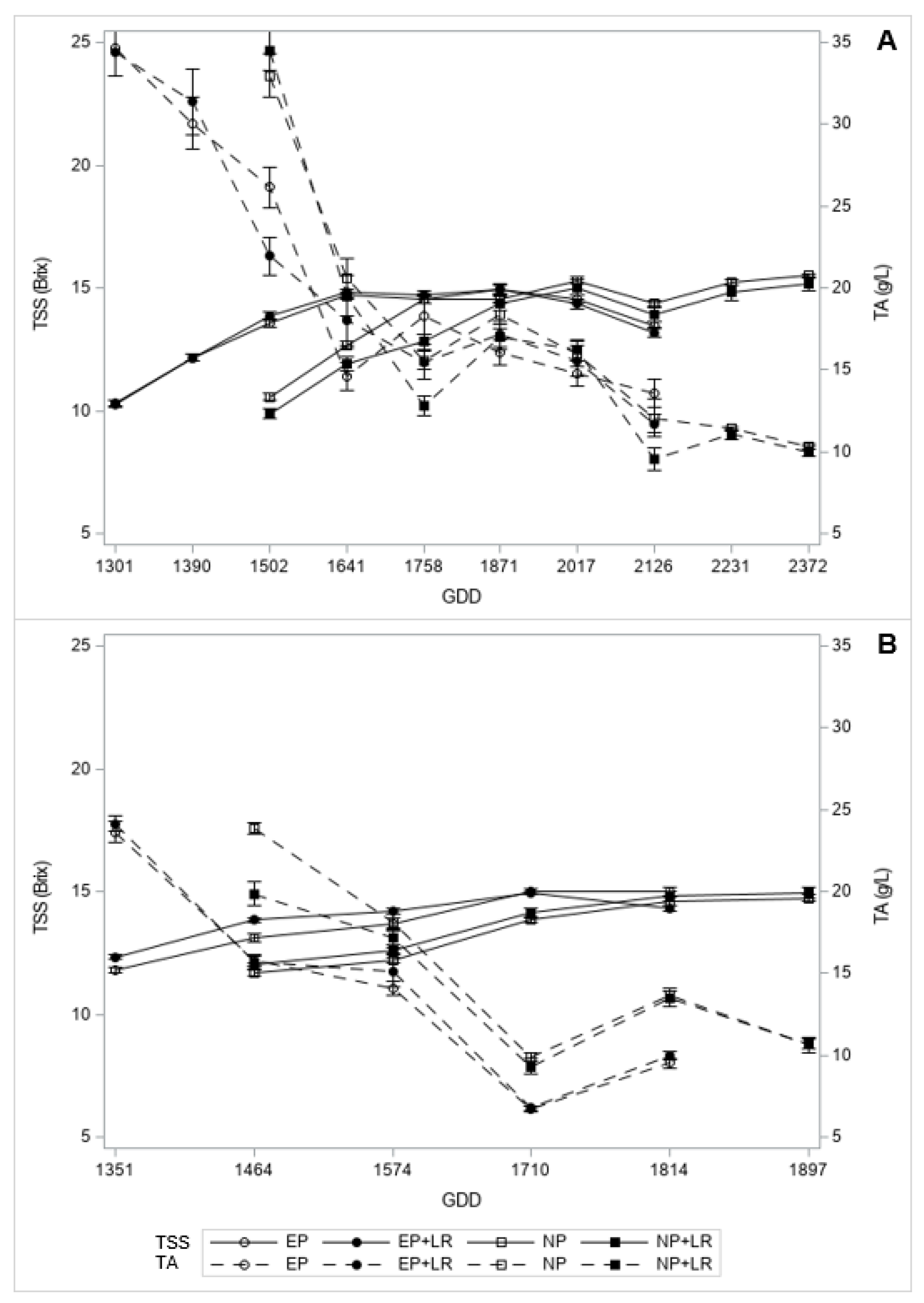
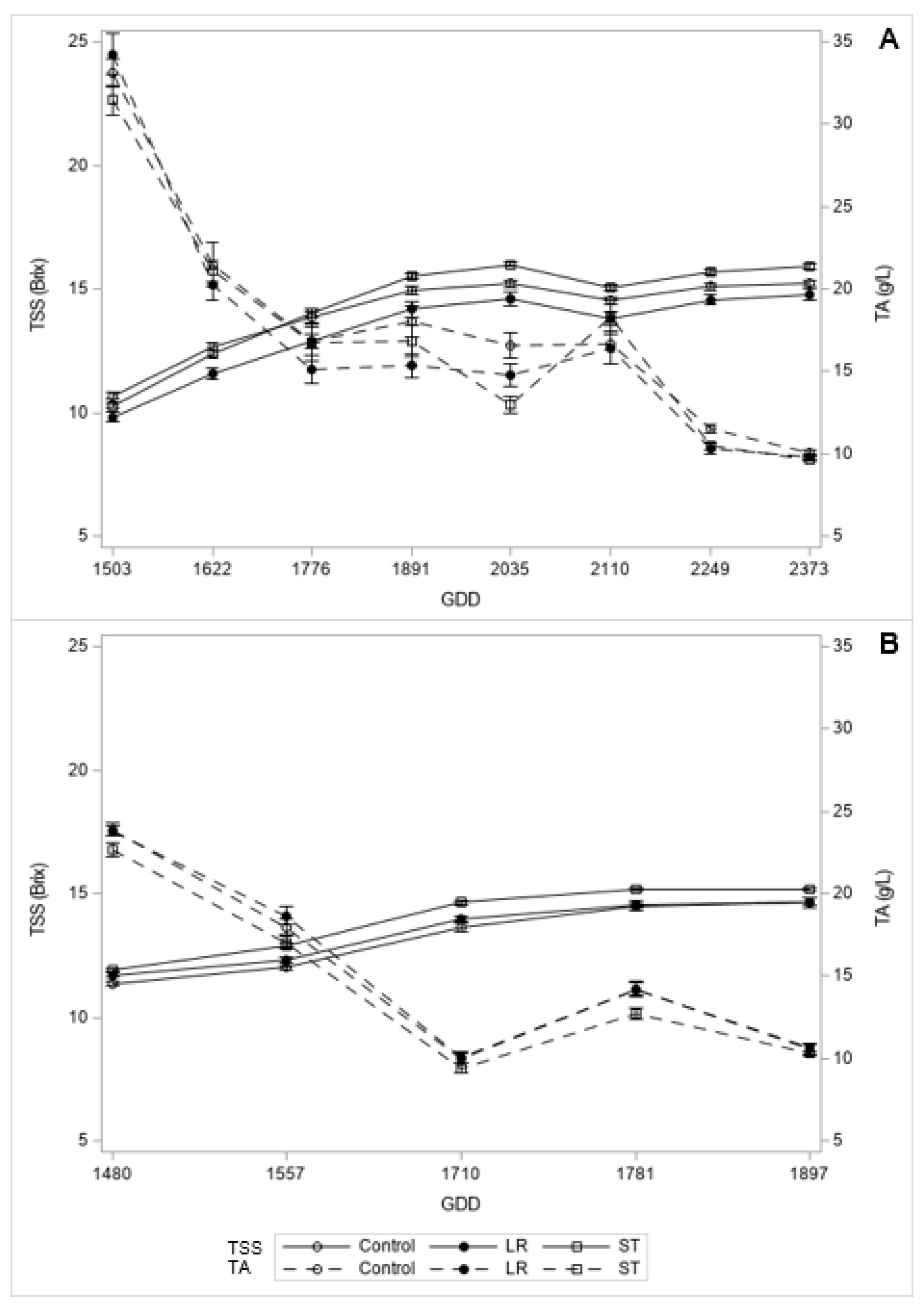
| 2020 | 2021 | ||||||||||
|---|---|---|---|---|---|---|---|---|---|---|---|
| Week | Phenological Stage of Early Pruned Vines a | Phenological Stage of Normal Pruned Vines a | Temperature (°C) b | Humidity (%) c | Rainfall (cm) b | Week | Phenological Stage of Early Pruned Vines | Phenological Stage of Normal Pruned Vines | Temperature (°C) | Humidity (%) | Rainfall (cm) |
| 1–16 June | 35 | 25.2 | 61.4 | 3.0 | |||||||
| 16–23 June | 25.8 | 65.7 | 0.1 | ||||||||
| 23 June–1 July | 36 | 35 | 27.1 | 79.4 | 4.6 | ||||||
| 1–8 July | 27.1 | 83.3 | 11.8 | 29 June-7 July | 35 | 24.0 | 80.5 | 2.5 | |||
| 8–14 July | 37 | 36 | 28.4 | 70.1 | 3.6 | 7–14 July | 36 | 35 | 25.7 | 81.8 | 7.4 |
| 14–22 July | 28.4 | 72.8 | 4.8 | 14–22 July | 37 | 36 | 27.0 | 79.1 | 11.1 | ||
| 22–29 July | 38 | 37 | 26.1 | 87.2 | 7.5 | 22–29 July | 38 | 37 | 25.1 | 75.7 | 5.2 |
| 29 July-4 August | 27.4 | 74.0 | 1.7 | 29 July–3 August | 38 | 26.2 | 81.9 | 3.7 | |||
| 4–12 August | 38 | 27.5 | 69.0 | 0 | |||||||
| Treatment (T) a | Berries per Cluster | Berry wt. (g) | Cluster wt. (g) | Yield (kg/vine) | Yield (kg/ha) | Ravaz Index (kg/kg) | TSS b (Brix) | TA c (g/L) | Juice pH |
|---|---|---|---|---|---|---|---|---|---|
| 2020 | |||||||||
| 1.1 | 14 ± 4 b d | 3.21 ± 0.16 a | 44.55 ± 15.10 | 2.65 ± 1.30 bc | 2441.15 ± 981.34 ab | . e | 13.48 ± 0.46 b | 13.58 ± 3.01 a | 3.31 ± 0.09 |
| 1.2 | 14 ± 1 b | 2.87 ± 0.22 b | 40.00 ± 0.00 | 1.47 ± 0.91 c | 1473.27 ± 647.13 b | . | 13.19 ± 0.70 b | 11.74 ± 2.01 ab | 3.30 ± 0.12 |
| 1.3 | 21 ± 8 a | 2.80 ± 0.26 b | 62.73 ± 26.11 | 5.11 ± 2.53 a | 4369.33 ± 2164.65 a | . | 15.18 ± 0.91 a | 10.03 ± 0.94 b | 3.30 ± 0.06 |
| 1.4 | 18 ± 7 ab | 3.12 ± 0.14 a | 60.83 ± 25.75 | 4.45 ± 2.57 ab | 3804.88 ± 2199.02 a | . | 15.49 ± 0.36 a | 10.34 ± 0.49 b | 3.38 ± 0.07 |
| p value | * f | *** | ns | *** | ** | *** | *** | ns | |
| Vintage (V) Avg | 17 ± 6 B g | 3.00 ± 0.26 A | 52.50 ± 21.90 | 3.38 ± 2.39 A | 3075.15 ± 1978.63 A | . | 14.32 ± 1.20 B | 11.45 ± 2.32 A | 3.32 ± 0.09 B |
| 2021 | |||||||||
| 1.1 | 21 ± 9 ab | 2.59 ± 0.20 b | 49.09 ± 20.23 b | 2.34 ± 0.71 b | 2134.69 ± 425.21 b | 1.73 ± 0.83 b | 15.02 ± 0.61 a | 9.53 ± 1.08 b | 3.62 ± 0.04 a |
| 1.2 | 18 ± 2 b | 2.58 ± 0.28 b | 40.00 ± 0.00 b | 0.98 ± 0.44 c | 859.75 ± 385.96 c | 0.95 ± 0.67 b | 14.33 ± 0.37 b | 10.00 ± 0.79 ab | 3.58 ± 0.06 ab |
| 1.3 | 25 ± 10 ab | 2.72 ± 0.30 ab | 65.00 ± 26.73 ab | 2.45 ± 1.39 b | 2159.21 ± 1289.23 b | 8.85 ± 5.29 a | 14.95 ± 0.73 ab | 10.65 ± 1.61 ab | 3.55 ± 0.05 b |
| 1.4 | 32 ± 14 a | 2.87 ± 0.22 a | 90.00 ± 40.82 a | 4.14 ± 1.46 a | 3380.69 ± 1219.90 a | 5.83 ± 3.22 a | 14.74 ± 0.57 ab | 10.71 ± 0.96 a | 3.54 ± 0.05 b |
| p value | * | * | *** | *** | *** | *** | * | * | ** |
| V Avg | 24 ± 10 A | 2.69 ± 0.27 B | 59.70 ± 30.46 | 2.48 ± 1.55 B | 2134.50 ± 1192.64 B | 4.24 ± 4.36 | 14.76 ± 0.62 A | 10.21 ± 1.21 B | 3.57 ± 0.06 A |
| T Avg over Both V | |||||||||
| 1.1 | 18 ± 8 AB h | 2.90 ± 0.36 AB | 46.82 ± 17.56 BC | 2.50 ± 1.40 B | 2287.92 ± 754.51 BC | 1.73 ± 0.83 B | 14.25 ± 0.95 B | 11.55 ± 3.03 A | 3.46 ± 0.17 |
| 1.2 | 15 ± 2 B | 2.73 ± 0.29 C | 40.00 ± 0.00 C | 1.22 ± 0.74 C | 1220.64 ± 623.13 C | 0.95 ± 0.65 B | 13.76 ± 0.80 C | 10.87 ± 1.74 AB | 3.44 ± 0.17 |
| 1.3 | 23 ± 9 A | 2.76 ± 0.28 BC | 63.68 ± 25.65 AB | 3.78 ± 2.41 A | 3438.76 ± 2122.83 AB | 8.85 ± 5.29 A | 15.07 ± 0.82 A | 10.34 ± 1.32 B | 3.43 ± 0.14 |
| 1.4 | 23 ± 12 A | 3.00 ± 0.22 A | 71.58 ± 34.20 A | 4.29 ± 2.05 A | 3648.60 ± 1869.59 A | 5.83 ± 3.22 A | 15.12 ± 0.60 A | 10.53 ± 0.77 AB | 3.46 ± 0.10 |
| p value | |||||||||
| T | *** | *** | *** | *** | *** | *** | *** | * | ns |
| V | *** | *** | ns | ** | ** | . | *** | *** | *** |
| T × V | ns | *** | ns | * | ns | . | *** | *** | ** |
| 2020 | 2021 | ||||||||
|---|---|---|---|---|---|---|---|---|---|
| Week | Phenological Stage of Vines a | Temperature (°C) b | Humidity (%) c | Rainfall (cm) b | Week | Phenological Stage of Vines | Temperature (°C) | Humidity (%) | Rainfall (cm) |
| 23–30 June | 35 | 26.7 | 79.1 | 4.6 | |||||
| 30 June-9 July | 27.3 | 80.8 | 14.5 | ||||||
| 9–15 July | 36 | 28.8 | 71.7 | 2.5 | 8–13 July | 35 | 25.5 | 83.3 | 7.4 |
| 15–23 July | 28.2 | 75.0 | 5.1 | 13–22 July | 36 | 26.8 | 82.0 | 11.9 | |
| 23–28 July | 37 | 25.4 | 91.5 | 6.6 | 22–27 July | 37 | 24.8 | 77.5 | 1.5 |
| 28 July–August 5 | 27.1 | 74.1 | 3.8 | 27 July–3 August | 38 | 25.9 | 80.2 | 3.8 | |
| 5–12 August | 38 | 27.6 | 68.6 | 0 | |||||
| Treatment (T) a | Berries per Cluster | Berry wt. (g) | Cluster wt. (g) | Yield (kg/vine) | Yield (kg/ha) | Ravaz Index (kg/kg) | TSS b (Brix) | TA c (g/L) | Juice pH |
|---|---|---|---|---|---|---|---|---|---|
| 2020 | |||||||||
| 2.1 | 25 ± 12 | 2.89 ± 0.34 b d | 75.26 ± 31.86 | 3.84 ± 2.37 a | 6172.82 ± 3550.02 a | . e | 14.79 ± 1.01 b | 9.83 ± 0.68 | 3.34 ± 0.08 b |
| 2.2 | 19 ± 10 | 3.06 ± 0.14 ab | 60.00 ± 30.29 | 1.37 ± 0.96 b | 2292.76 ± 1440.88 b | . | 15.93 ± 0.59 a | 9.68 ± 0.66 | 3.42 ± 0.10 a |
| 2.3 | 22 ± 11 | 3.12 ± 0.16 a | 71.57 ± 34.84 | 3.54 ± 2.96 a | 5930.25 ± 4405.59 a | . | 15.23 ± 0.58 b | 10.08 ± 0.68 | 3.42 ± 0.07 a |
| p value | ns f | * | ns | ** | ** | *** | ns | ** | |
| Vintage (V) Avg | 22 ± 11 | 3.02 ± 0.25 A g | 69.11 ± 32.49 | 2.92 ± 2.48 A | 4843.36 ± 3777.05 A | . | 15.32 ± 0.88 A | 9.86 ± 0.68 B | 3.39 ± 0.09 B |
| 2021 | |||||||||
| 2.1 | 22 ± 8 | 2.62 ± 0.28 | 55.38 ± 24.02 | 1.67 ± 1.10 b | 3303.75 ± 1525.56 | 10.72 ± 8.17 a | 14.68 ± 0.64 b | 10.69 ± 1.27 | 3.56 ± 0.08 |
| 2.2 | 25 ± 8 | 2.57 ± 0.23 | 61.43 ± 25.68 | 1.80 ± 0.68 ab | 2620.23 ± 1118.62 | 3.95 ± 3.23 b | 15.19 ± 0.29 a | 10.31 ± 0.58 | 3.57 ± 0.05 |
| 2.3 | 26 ± 9 | 2.62 ± 0.32 | 63.33 ± 25.82 | 2.67 ± 1.44 a | 3778.02 ± 2189.36 | 7.98 ± 9.55 ab | 14.65 ± 0.85 b | 10.56 ± 1.25 | 3.55 ± 0.05 |
| p value | ns | ns | ns | * | ns | * | * | ns | ns |
| V Avg | 24 ± 9 | 2.60 ± 0.28 B | 60.24 ± 24.84 | 2.05 ± 1.19 B | 3245.29 ± 1718.43 B | 7.49 ± 7.86 | 14.84 ± 0.67 B | 10.52 ± 1.07 A | 3.56 ± 0.06 A |
| T Avg over Both V | |||||||||
| 2.1 | 24 ± 11 | 2.76 ± 0.34 | 67.19 ± 30.19 | 2.75 ± 2.13 A | 5007.26 ± 3204.40 A h | 10.72 ± 8.17 A | 14.74 ± 0.84 B | 10.26 ± 1.09 | 3.45 ± 0.14 B |
| 2.2 | 22 ± 9 | 2.81 ± 0.31 | 60.63 ± 27.93 | 1.59 ± 0.85 B | 2436.03 ± 1300.19 B | 3.95 ± 3.23 B | 15.56 ± 0.59 A | 10.00 ± 0.69 | 3.49 ± 0.11 A |
| 2.3 | 24 ± 11 | 2.87 ± 0.36 | 67.94 ± 31.02 | 3.10 ± 2.34 A | 4980.73 ± 3714.43 A | 7.98 ± 9.55 AB | 14.94 ± 0.78 B | 10.32 ± 1.02 | 3.48 ± 0.09 AB |
| p value | |||||||||
| T | ns | ns | ns | *** | *** | * | *** | ns | * |
| V | ns | *** | ns | ** | * | . | *** | *** | *** |
| T × V | ns | ns | ns | ** | ns | . | ns | ns | * |
Disclaimer/Publisher’s Note: The statements, opinions and data contained in all publications are solely those of the individual author(s) and contributor(s) and not of MDPI and/or the editor(s). MDPI and/or the editor(s) disclaim responsibility for any injury to people or property resulting from any ideas, methods, instructions or products referred to in the content. |
© 2023 by the authors. Licensee MDPI, Basel, Switzerland. This article is an open access article distributed under the terms and conditions of the Creative Commons Attribution (CC BY) license (https://creativecommons.org/licenses/by/4.0/).
Share and Cite
Williams, H.N.; Stafne, E.T.; Zhang, Y.; Chang, S.K.C. Evaluating the Effects of Early Pruning, Leaf Removal, and Shoot Thinning on ‘MidSouth’ Grapes over Two Consecutive Vintages in South Mississippi. Agronomy 2023, 13, 368. https://doi.org/10.3390/agronomy13020368
Williams HN, Stafne ET, Zhang Y, Chang SKC. Evaluating the Effects of Early Pruning, Leaf Removal, and Shoot Thinning on ‘MidSouth’ Grapes over Two Consecutive Vintages in South Mississippi. Agronomy. 2023; 13(2):368. https://doi.org/10.3390/agronomy13020368
Chicago/Turabian StyleWilliams, Haley N., Eric T. Stafne, Yan Zhang, and Sam K.C. Chang. 2023. "Evaluating the Effects of Early Pruning, Leaf Removal, and Shoot Thinning on ‘MidSouth’ Grapes over Two Consecutive Vintages in South Mississippi" Agronomy 13, no. 2: 368. https://doi.org/10.3390/agronomy13020368
APA StyleWilliams, H. N., Stafne, E. T., Zhang, Y., & Chang, S. K. C. (2023). Evaluating the Effects of Early Pruning, Leaf Removal, and Shoot Thinning on ‘MidSouth’ Grapes over Two Consecutive Vintages in South Mississippi. Agronomy, 13(2), 368. https://doi.org/10.3390/agronomy13020368








